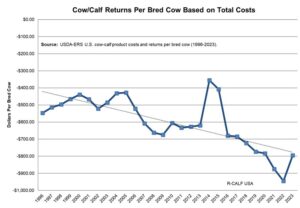FOR PRODUCER PROFITABILITY – FOLLOW THE MONEY
June 18, 2024
Op-Ed by Gilles Stockton, Montana Cattlemen’s Association Director
This past spring the Montana Stockgrowers Association (MSGA) held a number of what they termed “Producer Profitability” meetings in order to solicit support for the MSGA’s farm policy priorities. Their agenda includes: increased government subsidies for the Livestock Risk Protection Program (LRP); streamlining the process to employ migrant workers through the H-2B visa program; and the continuation of the $26 million exemption for inheritance tax. These three priorities would continue the status quo in farm policy and primarily benefit the larger outfits. However, it falls short of providing actual producer profitability.
Many in the audience expressed a very different priority. It came up at a number of the meetings that ranch families are concerned about transferring their ranches to their kids. Given the trends in the livestock market they worry if the younger generation can survive financially.

The above chart (courtesy of R-Calf USA) perfectly explains the issue and the cause for the worry. Over the past forty years cattle producers have lost twenty-six cents (26%) of the consumer dollar to the beef packers and large retail stores. The trend is clear. Unless something is changed, it is probable that we shall lose even more of the potential profit in raising cattle. Clearly, the younger generation will find it very difficult to make a living ranching.

Follow the money! Consumers are buying beef and paying rather high prices for it. It is the packers and retailers that are pocketing the profit. This second chart (also from R-Calf USA) shows this trend. Packers are taking their cut, but the retail giants are taking the greater part of this theft. It is theft, because the retailers and packers are not adding new value – a T-bone steak is still a T-bone steak.
Packers and retail firms are able to get away with this theft because their dominant size gives them abusive market power. Cargill, Tyson, JBS, and National slaughter 85% of the fed cattle. Walmart, Costco, Kroger’s, and Albertsons, between them, control 45% of the grocery market. These giant retailers squeeze the packers who in turn squeeze the feeders, who then squeeze the ranchers.
Cow/calf producers have no one they can squeeze except for themselves. Ranchers try to make up the difference by raising more cattle, which means that they must work that much harder and take on that much more financial risk. Some survive by working at off-ranch jobs. Others sell feed supplements or haul cattle, hay, and grain. It is very difficult because the underlying economics is fraudulent.
The only solution we have is through enforcement of the Packers and Stockyards Act. Section 202 of which states:
“It shall be unlawful for any packer or swine contractor with respect to livestock, meats, meat food products, or livestock products in unmanufactured form…” in giving any “…undue or unreasonable preference or advantage…” which includes “…buying, selling or dealing in, any article…”.
(Bold print added in order to emphasize key concepts)
We have tended to focus on the market power that packers have in buying fed cattle and how the Act can remedy that situation. Not as much attention or thought has been given to the other side of the equation – how the packers sell the beef.
Just as in 1921, the solution to curbing the packer’s market power in cattle buying is to require that they buy in an open, transparent, and publicly competitive market forum. Ideally, this would be a video/electronic market. An added advantage to this approach is that smaller start-up packers would be able to bid on an equal basis for their fed cattle. This is how the packer cartel of the 1920’s was brought under control.
By the same token, requiring that packers sell beef through a competitive auction mechanism would result in the large retailers not being able to dictate prices. Such a competitive market for beef would allow smaller start-up packers to have equal access to the retail market. By embracing free market competition, we would also eliminate the disadvantage that smaller grocers have in procuring beef at a competitive price. Enhancing competition at the wholesale level would benefit everyone including consumers.
The Packers and Stockyards Act has been on the books for more than a hundred years, and yet for the past fifty years it has been systematically ignored. One reason for this is that two of the national organizations that claim to represent cattle producers lobbies instead for the packer cartel. Until organizations like the MSGA and their grassroots members stand up for their own economic interests and demand that these national organizations support transparent competitive markets – nothing will change.
If nothing changes in the cattle market, chances are that our heirs will have no choice but to eventually sell the land, that we all love so dearly, to the American Prairie Reserve or some out-of-state multi-millionaire.
Contact person:
Gilles Stockton (406) 428-2183
Montana Cattlemen’s Association
mca@montanacattlemen.org